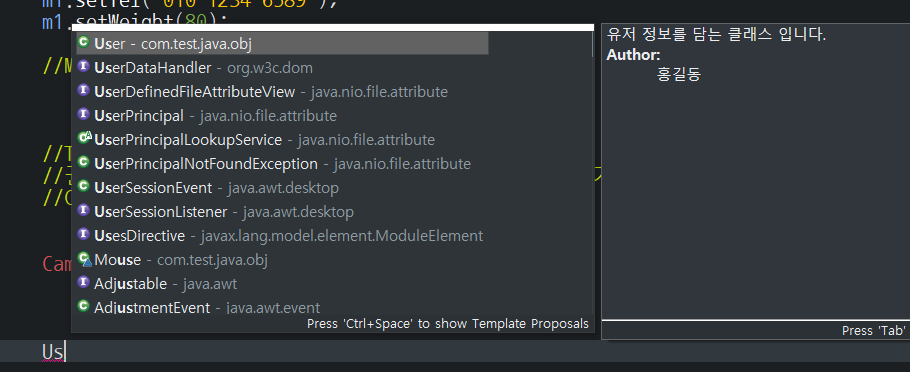2021.04.20
용어
-
형변환
- 암시적 형변환, 명시적 형변환
- 자동 타입 변환, 강제 타입 변환
-
변수
- 객체 변수, 인스턴스 변수, (멤버 변수)
- 정적 변수, static 변수, (클래스 변수)
-
Object
-
Instance : 메모리에 실체화된 객체(Object)다.
- 메소드(Method), 함수(Function), 프로시저(Procedure), 서브루틴(SubRoutine), 행동(Behavior)..
- 클래스 멤버 변수(객체, 정적) == 특성(Property) == 속성(Attribute) == 필드(Field)
Constructor, 생성자
- 특수한 목적을 가지는 메소드
- 객체를 초기화하는 역할(객체 멤버 변수를 초기화 or 기타 초기화 작업)
기본 생성자
- 인자 값이 없는 생성자
- 기본 생성자는 개발자가 만들지 않으면 자바가 자동으로 만든다.
- 인자값이 있는 생성자를 개발자가 만들면 기본 생성자를 더이상 자동으로 만들어지지 않는다.
A. 기본생성자
public class Ex40_Constructor {
public static void main(String[] args) {
//클래스명 변수 = 객체생성연산자 생성자();
//1. new -> 객체 생성 -> 모든 변수는 null
//2. Person() -> 생성자를 안만들면 자동으로 생성해줌 -> null, 0 (초기셋팅)
//3. Persin p -> 참조변수 p
//4. = -> 주소값 복사
Person p = new Person();
//초기화를 입력한 것을 주석 처리해도 null, 0이 출력된 이유? -> 기본 생성자.
//객체 초기화(Setter)
//p.setName("익명");
//p.setAge(-1);
System.out.println(p.getName());
System.out.println(p.getAge());
}//main
}
class Person {
//멤버 변수
private String name;
private int age;
//기본생성자
// - 인자값이 없는 생성자
// - 기본 생성자는 개발자가 만들지 않으면 자바가 자동으로 만든다.
// - 인자값이 있는 생성자를 개발자가 만들면 기본 생성자를 더이상 자동으로 만들어지지 않는다.
public Person() {
//멤버 초기화 기본값
//1. 정소 -> 0
//2. 실수 -> 0.0
//3. 문자 ->\0
//4. 논리 -> false
//5. 참조 -> null
this.name = null;
this.age = 0;
}
//Getter, Setter
public String getName() {
return name;
}
public void setName(String name) {
this.name = name;
}
public int getAge() {
return age;
}
public void setAge(int age) {
this.age = age;
}
}B. 생성자
public class Ex40_Constructor {
public static void main(String[] args) {
//Person 객체를 100개 생성 -> "익명" , -1
Person p = new Person();
//p.setName("익명");
//p.setAge(-1);
System.out.println(p.getName());
System.out.println(p.getAge());
Person p2 = new Person();
//객체 초기화(Setter) -> 현실: 수정
//p2.setName("익명");
//p2.setAge(-1);
System.out.println(p2.getName());
System.out.println(p2.getAge());
}//main
}
class Person {
//멤버 변수
private String name;
private int age;
//생성자
// - 메서드
// 1. 메소드명이 클래스명과 동일한다.
// 2. 반환형을 명시하지 않는다. > 반환값을 돌려주는 목적의 메소드가 아니다.
// 3. 멤버 초기화를 구현한다.
// public Person() {
// this.name = "아무개";
// this.age = 100;
// }
public Person() {
this.name = "익명";
this.age = -1;
}
//Getter, Setter
public String getName() {
return name;
}
public void setName(String name) {
this.name = name;
}
public int getAge() {
return age;
}
public void setAge(int age) {
this.age = age;
}
}C. 생성자 오버로딩(= 메소드 오버로딩)
public class Ex40_Constructor {
public static void main(String[] args) {
//Person 객체를 100개 생성 -> "익명" , -1
Person p = new Person();
System.out.println(p.getName());
System.out.println(p.getAge());
Person p2 = new Person();
System.out.println(p2.getName());
System.out.println(p2.getAge());
//p, p2 : 익명, -1
//p3 : 홍길동, 20
//p4 : 아무개, 25
//Person p3 = new Person(); // 공산품 생산.. 항상 같은 모습만 생성
Person p3 = new Person("홍길동", 20); //메소드 인자값 전달 -> 주문 생산이 가능해졌음, 원하는 모습으로 생성
//p3.setName("홍길동");
//p3.setAge(20);
System.out.println(p3.getName());
System.out.println(p3.getAge());
Person p4 = new Person();
p4.setName("아무개");
p4.setAge(25);
System.out.println(p4.getName());
System.out.println(p4.getAge());
}//main
}
class Person {
//멤버 변수
private String name;
private int age;
//생성자 오버로딩(= 메소드 오버로딩)
public Person(String name, int age) {
this.name = name;
this.age = age;
}
public Person(String name) {
this.name = name;
this.age = -1;
}
public Person (int age) {
this.name = "익명";
this.age = age;
}
//Getter, Setter
public String getName() {
return name;
}
public void setName(String name) {
this.name = name;
}
public int getAge() {
return age;
}
public void setAge(int age) {
this.age = age;
}
}생성자 vs Setter
-
공통점
a. 생성자 : 객체변수의 값을 대입할 수 있다.
b. Setter : 객체 변수의 값을 대입할 수 있다.
-
차이점
a. 생성자 : 객체가 처음 만들어질 때 자동으로 호출된다.
- 2번이상 호출이 불가능하다.(객체가 태어날때 딱 1번만 실행되고 그 이후에 호출이 불가능하다.)
- 역할 : 초기화★★★★★
b. Setter : 개발자가 원하는 시점에 직접 호출한다.
- N번 이상 호출이 가능하다.
-
역할 : 수정자 ★★★★★
생성자를 사용하는 이유?
- 문법의 발전 -> 수많은 목적으로 발전
- 생산자보다 소비자의 입장을 우선한다. ★★★★★
- 생산자 : 클래스를 설계하는 개발자
- 소비자 : 클래스를 사용해서 객체를 생성하는 개발자
- 생성자 : 생산자를 위한 기술이 아니라, 소비자를 위한 기술이다.
- 생산자가 클래스를 만드는 횟수 : 평생 1번
- 소비자가 클래스를 사용해서 객체를 만드는 횟수 : 0 ~ n번 -> 그래서 우선★
★★★★ 인자값이 있는 생성자를 개발자가 만들면 기본 생성자는 더이상 자동으로 만들어지지 않는다.
그래서 기본 생성자는 되도록 생성해두는 편이 좋다!!! ★★★★
public class Ex40_Constructor {
public static void main(String[] args) {
//생성자를 사용하는 이유
Person p5 = new Person(); //익명, -1
Person p6 = new Person("홍길동", 20); //홍길동, 20
Person p7 = new Person("아무개"); //아무개, -1
Person p8 = new Person(22); //익명, 22
//생성자를 사용하는 이유
Member m1 = new Member();
m1.setNo("10");
m1.setName("홍길동");
m1.setAddress("서울시");
m1.setAge(20);
m1.setAddress("hong@gmail.com");
m1.setGender("남자");
m1.setHeight(180);
m1.setPoint(100);
m1.setTel("010-1234-6589");
m1.setWeight(80);
Member m2 = new Member("20", "아무개", "test@test.com", "010-1234-1234", "서울시", 22, 170, 60, "남자", 200);
}//main
}
class Person {
//멤버 변수
private String name;
private int age;
//생성자 오버로딩(= 메소드 오버로딩)
public Person(String name, int age) {
this.name = name;
this.age = age;
}
public Person(String name) {
this.name = name;
this.age = -1;
}
public Person (int age) {
this.name = "익명";
this.age = age;
}
//Getter, Setter
public String getName() {
return name;
}
public void setName(String name) {
this.name = name;
}
public int getAge() {
return age;
}
public void setAge(int age) {
this.age = age;
}
}
class Member {
private String no;
private String name;
private String email;
private String tel;
private String address;
private int age;
private int height;
private inteight;
private String gender;
private int point;
public Member() {
}
public Member(String no, String name, String email,String tel,String address, int age, int height, int weight, String gender, int point) {
this.no = no;
this.name = name;
this.email = email;
this.tel = tel;
this.address = address;
this.age = age;
this.height = height;
this.weight = weight;
this.gender = gender;
this.point = point;
}
public String getNo() {
return no;
}
public void setNo(String no) {
this.no = no;
}
public String getName() {
return name;
}
public void setName(String name) {
this.name = name;
}
public String getEmail() {
return email;
}
public void setEmail(String email) {
this.email = email;
}
public String getTel() {
return tel;
}
public void setTel(String tel) {
this.tel = tel;
}
public String getAddress() {
return address;
}
public void setAddress(String address) {
this.address = address;
}
public int getAge() {
return age;
}
public void setAge(int age) {
this.age = age;
}
public int getHeight() {
return height;
}
public void setHeight(int height) {
this.height = height;
}
public int getWeight() {
return weight;
}
public void setWeight(int weight) {
this.weight = weight;
}
public String getGender() {
return gender;
}
public void setGender(String gender) {
this.gender = gender;
}
public int getPoint() {
return point;
}
public void setPoint(int point) {
this.point = point;
}
}생성자 this
- 생성자는 또 다른 생성자를 호출할 수 있다.
- 반복되는 코드의 중복을 제거할 수 있다.
public class Ex40_Constructor {
public static void main(String[] args) {
//The constructor Camera() is undefined
//권장사항 : 보통은 인자가 없는 기본 생성자가 있을거라고 예상
//Camera c1 = new Camera();
Camera c1 = new Camera("A001", "white");
}
}
class Camera {
private String model;
private String color;
//기본생성자는 되도록 생성하는 편이 좋다.(강제는 아님..)
public Camera() {
//this.model = "none";
//this.color = "none";
this("none", "none");
}
// ********생성자는 또 다른 생성자를 호출할 수 있다.(생성자 끼리 -> 불려지는 시점이 동일하기 때문에)
// 기준이 되는 코드 : 코드들 중 기능이 많은 코드를 선택(할 수 있는 일이 많은 코드)
public Camera(String model, String color) {
if(model.equals("none") || model.equals("A001") ||model.equals("B001")) {
this.model = model;
}
this.color = color;
}
public Camera(String model) {
this(model,"none");
// if(model.equals("none") || model.equals("A001") ||model.equals("B001") || model.equals("C001")) {
// this.model = model;
// }
// this.color = "none";
}
}문서 주석
-
해당 클래스를 사용하는 개발자들에게 알려주는 클래스 사용법
- 도움말을 만든다. -> Documentation(기술문서)
- 작업 중 풍선 도움말에 보여진다. > 개인작업, 팀작업에 도움이 된다.
- 이 주석들만 모아서 별도의 도움말 파일을 생성 할 수 있다. > javadoc.exe
/** 쓰고 Enter치기
/**
*
* 유저 정보를 담는 클래스 입니다.
* @author 홍길동
*
*/
public class User {
private String name;
private String id;
private String pw;
/**
* 기본생성자 입니다.
* 모든 멤버를 빈 문자열로 초기화 합니다.
*/
public User() {
this.name = "";
this.id = "";
this.pw = "";
}
/**
* 매개변수를 가지는 생성자 입니다.
* @param name 유저명
* @param id 아이디
* @param pw 비밀번호
*/
public User(String name, String id, String pw) {
this.name = name;
this.id = id;
this.pw = pw;
}
/**
* 유저명 Getter
* @return 유저명
*/
public String getName() {
return name;
}
/**
* 유저명 Setter
* @param name 유저명
*/
public void setName(String name) {
this.name = name;
}
public String getId() {
return id;
}
public void setId(String id) {
this.id = id;
}
public String getPw() {
return pw;
}
public void setPw(String pw) {
this.pw = pw;
}
}- 문서 주석의 역할 - 작업 중 풍선 도움말에 보여진다. > 개인작업, 팀작업에 도움이 된다.

- 이 주석들만 모아서 별도의 도움말 파일을 생성 할 수 있다. > javadoc.exe
- 해당 프로젝트 선택 - export - java- javadoc

- C:\Program Files\Java\jdk1.8.0_281\bin\javadoc.exe

- 패키지 선택
- 한글 깨짐 방지
- VM optins에-locale ko_KR -encoding UTF-8 -charset UTF-8 -docencoding UTF-8 입력.

- 결과 확인(산출물) -> 파일 위치 : C:\class\java\JavaTest\doc -> index.html 선택

- 지역 변수의 생명주기
- 변수 선언문이 실행(생성) ~ 해당 영역 종료(소멸)
- 객체 변수의 생명주기
- new, 객체가 생성될 때(생성) ~ 객체의 참조가 모두 끊겨서 가비지가 되고 GC가 그 객체를 회수해가는 순간(소멸)
- 정적 변수의 생명주기
- main() 메소드 실행전(생성) ~ main() 메소드 종료후(소멸)
- 프로그램 시작(생성) ~ 프로그램 종료(소멸)
정적멤버 & 객체 멤버
public class Ex40_Constructor {
public static void main(String[] args) {
//Monitor
// - 객체 멤버(model) > 메모리에 아직 없음
// - 정적 멤버(Owner) > 메모리에 이미 있음
//★★★★ 정적 멤버를 객체 생성을 통해서 초기화를 해야만 하는게 올바른 행동인가?
// -> 정적 멤버의 초기화는 객체 생성 유무와 상관없이 별도로 실행되야 한다.
System.out.println(Monitor.getOwner()); //null
//Monitor m = new Monitor(); //이 행동(Monitor())이 이상하다!! -> 생성자 안에서 객체(변수)초기화 + 정적 (변수)초기화)
System.out.println(Monitor.getOwner()); //홍길동
//static을 잘 사용안한다. > 사용하기가 어렵다.
//a. 변수 -> 데이터 저장용 -> 사물함
//1. 객체 변수 -> 개인 사물함
//2. 정적 변수 -> 공용 사물함.
//개인(홍길동) 사물함 -> 스마트폰 -> 분실 -> ???
//공용 사물함 -> 스마트폰 -> 분실 -> ?? -> (접근 더 어려움, 원인 찾기 어려움. 컨트롤 어려움)
//b.생명주기
//메모리에 항상 상주하기 때문에 너무 많이 만들면 좋지 않음.
//m : 지역변수
Monitor m = new Monitor(); // new -> model 변수 생성
}
}
class Monitor {
private String model; //멤버(객체) -> 개인정보
private static String owner; //멤버(정적) -> 공용정보
//객체 생성자
//-> 객체 내부에 있는 멤버를 초기화하는 역할
//-> 정적 멤버를 초기화 하지 않는다.(x) -> 논리에 안맞음..
public Monitor() { // new Monitor();
this.model = "M100";
//Monitor.owner = "홍길동";
}
//정적 생성자
// - 정적 멤버를 초기화 하는 전용 생성자
// - main() 실행 전에 호출된다.
static {
Monitor.owner = "홍길동";
}
public String getModel() {
return model;
}
public void setModel(String model) {
this.model = model;
}
public static String getOwner() {
return owner;
}
public static void setOwner(String owner) {
Monitor.owner = owner;
}
}상속, Inheritance
- 클래스 상속
- 클래스와 클래스간에 구현 가능한 기술
- 부모 -> (재산) -> 자식
- 클래스 -> (멤버(변수, 메소드)) -> 클래스
- 상속은 자식이 부모의 멤버를 거부할 권한이 없다. > 무조건 100% 물려받는다.
- JDK기준 > 1단계 ~ 6~7단계
- 부모 클래스 -> 자식 클래스 // 상속(Inheritance)
- 슈퍼 클래스 -> 서브 클래스
- 기본 클래스 -> 확장 클래스
상속을 왜 하는지?
-> 코드 재사용★★★★★★★★★★★★★★★★★★★★★★★★
public class Ex41_inheritance {
public static void main(String[] args) {
//부모 클래스
Parent p = new Parent();
System.out.println(p.a);
System.out.println(p.b);
p.aaa();
//System.out.println(p.c);
//System.out.println(p.d);
//p.bbb()
System.out.println();
//자식 클래스
Child c = new Child();
//부모로부터 상속받은 멤버
System.out.println(c.a);
System.out.println(c.b);
c.aaa();
//자신이 구현한 멤버
System.out.println(c.c);
System.out.println(c.d);
c.bbb();
//손자 클래스
GrandChild g = new GrandChild();
//할아버지가 물려준 멤버 (Parent 클래스)
System.out.println(g.a);
System.out.println(g.b);
g.aaa();
//아버지가 물려준 멤버(Child 클래스)
System.out.println(g.c);
System.out.println(g.d);
g.bbb();
//자신이 구현한 멤버(GrandChild 클래스)
System.out.println(g.e);
System.out.println(g.f);
g.ccc();
}//main
}//Ex41
//부모 클래스(멤버 3개)
class Parent {
public int a = 10;
public int b = 20;
public void aaa() {
System.out.println("AAA");
}
}
//자식 클래스(멤버 6개)
// - 반드시 본인만의 멤버를 추가로 구현한다.(******)
class Child extends Parent { // Parent 클래스를 부모로 해서 상속을 받겠다.(Parent와 Child를 상속 관계로 만든다.)
public int c = 30;
public int d = 40;
public void bbb() {
System.out.println("BBB");
}
}
//손자 클래스(멤버9개) > 생산성이 높아진다 + 사용이 어려워진다.
class GrandChild extends Child {
public int e = 50;
public int f = 60;
public void ccc() {
System.out.println("CCC");
}
}난수생성기
- Math.random() 메서드
- Random 클래스
- nextInt(int)
- nextInt()
- nextDouble()
public class Ex42_Inheritance {
public static void main(String[] args) {
//pseudorandom numbers -> 의사 난수 숫자들
Random rnd = new Random();
for(int i=0; i<10; i++) {
System.out.println(Math.random()); //0(inclusive)~1(exclusive)
System.out.println(rnd.nextInt()); //int 범위의 난수 반환 -> -21억~21억
System.out.println(rnd.nextInt(10)); //0inclusive)~10(exclusive)사이--> 0~9까지(범위 설정)
System.out.println(rnd.nextBoolean());
System.out.println(rnd.nextDouble());
System.out.println(rnd.nextLong());
}
}
}상황) 개발자. 담당 업무 > 난수 발생 잦음 > 난수 발생 코드 구현 잦음.
- -21억 ~ 21억
- 1 ~ 10
- 색상 난수 : red, yellow, blue, orange, green
- true, false
public class Ex42_Inheritance {
public static void main(String[] args) {
//s1();
//s2();
//s3();
s4();
}
}
private static void s4() {
//Random을 베이스로 해서 추가 기능을 넣은 클래스 -> 확장(extends)★★★
MyRandom2 my = new MyRandom2();
//1.
System.out.println(my.nextInt());
//2.
System.out.println(my.nextTinyInt());
//3.
System.out.println(my.nextColor());
//4.
System.out.println(my.nextBoolean());
System.out.println(my.nextLong());
System.out.println(my.nextDouble());
System.out.println(my.nextGaussian());
}
private static void s3() {
MyRandom my = new MyRandom();
//1. -21억 ~ 21억
System.out.println(my.nextInt());
System.out.println(my.nextInt());
System.out.println(my.nextInt());
System.out.println(my.nextInt());
System.out.println(my.nextInt());
//2. 1~10
System.out.println(my.nextTinyInt());
System.out.println(my.nextTinyInt());
System.out.println(my.nextTinyInt());
System.out.println(my.nextTinyInt());
System.out.println(my.nextTinyInt());
//3. 색상 난수 : red, yellow, blue, orange, green
System.out.println(my.nextColor());
System.out.println(my.nextColor());
System.out.println(my.nextColor());
System.out.println(my.nextColor());
System.out.println(my.nextColor());
}
private static void s2() {
Random rnd = new Random();
MyRandom my = new MyRandom();
//1. -21억 ~ 21억
System.out.println(rnd.nextInt()); //순수 Random기능
System.out.println(rnd.nextInt());
System.out.println(rnd.nextInt());
System.out.println(rnd.nextInt());
System.out.println(rnd.nextInt());
//2. 1~10
System.out.println(my.nextTinyInt());
System.out.println(my.nextTinyInt());
System.out.println(my.nextTinyInt());
System.out.println(my.nextTinyInt());
System.out.println(my.nextTinyInt());
//3. 색상 난수 : red, yellow, blue, orange, green
System.out.println(my.nextColor());
System.out.println(my.nextColor());
System.out.println(my.nextColor());
System.out.println(my.nextColor());
System.out.println(my.nextColor());
}
private static void s1() {
Random rnd = new Random();
//1. -21억 ~ 21억
System.out.println(rnd.nextInt()); //순수 Random기능
System.out.println(rnd.nextInt());
System.out.println(rnd.nextInt());
System.out.println(rnd.nextInt());
System.out.println(rnd.nextInt());
//2. 1~10
System.out.println(rnd.nextInt(10)); //순수 random 기능 + 사용자
System.out.println(rnd.nextInt(10));
System.out.println(rnd.nextInt(10));
System.out.println(rnd.nextInt(10));
System.out.println(rnd.nextInt(10));
//3. 색상 난수 : red, yellow, blue, orange, green
String[] color = {"red", "yellow", "blue", "orange", "green"};
System.out.println(color[rnd.nextInt(color.length)]); //순수 random 기능 + 사용자
System.out.println(color[rnd.nextInt(color.length)]);
System.out.println(color[rnd.nextInt(color.length)]);
System.out.println(color[rnd.nextInt(color.length)]);
System.out.println(color[rnd.nextInt(color.length)]);
}- s2(), s3()의 외부 클래스
public class MyRandom {
public int nextInt() { //구색 갖추기용
//1. -21억 ~ 21억
Random rnd = new Random();
return rnd.nextInt();
}
public int nextTinyInt() {
//2. 1~10
Random rnd = new Random();
return rnd.nextInt(10) + 1;
}
public String nextColor() {
//3. 색상 난수 : red, yellow, blue, orange, green
Random rnd = new Random();
String[] color = {"red", "yellow", "blue", "orange", "green"};
return color[rnd.nextInt(color.length)];
}
public boolean nextBoolean() { //구색 갖추기용
Random rnd = new Random();
return rnd.nextBoolean();
}
}- s4()의 외부 클래스 -> Random 클래스를 부모로 모든 기능을 상속 -> 효율적으로 코드를 작성할 수 있다. Random의 기능을 추가적으로 사용할 수 있다.
public class MyRandom2 extends Random { //Random 클래스를 부모로 모든 기능을 상속받는다.
//nextInt()
//nextBoolean()
public int nextTinyInt() {
//2. 1~10
Random rnd = new Random();
return rnd.nextInt(10) + 1;
}
public String nextColor() {
//3. 색상 난수 : red, yellow, blue, orange, green
Random rnd = new Random();
String[] color = {"red", "yellow", "blue", "orange", "green"};
return color[rnd.nextInt(color.length)];
}
}
